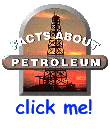|
What is a Refinery?
A typical refinery these days costs billions of dollars ($$$) to build, and millions more just to maintain and upgrade. Large refineries are complex operations that run 365 days a year, employ as many as 2,000 people, and may occupy as much land as several hundred football fields. Some are so big and sprawling that workers need to ride bicycles just to get from one part of the refinery complex to another. Yet refineries of today had surprisingly humble origins. For example, Kern County pioneers in the 1860's used mule-drawn wagons to haul a primitive still to a spot near the modern intersection of Twissleman Road and Highway 33 to erect the Buena Vista refinery. This pioneer operation boiled a few barrels a day of tarry oil, dipped by hand from shallow shafts that represented Kern County's first oil wells, to produce kerosene for lamps, lubricants for wagon wheels, waxes for candles, and gasoline--a clear, lightweight liquid that was usually thrown away as a useless byproduct. The lowly status of gasoline changed dramatically, when Charles Duryea in 1892 built the first gas-powered automobile in the United States. Within just a few short years cars became engrained our society, and the light stuff from crude oil became the right stuff. Today, refineries turn more than half of every 42-gallon barrel of crude oil into gasoline. This is a remarkable advance from 70 years ago when each barrel of crude yielded only 11 gallons of gasoline. How does this remarkable transformation take place? Actually, there are three basic steps common to all refining operations, whether big or small, simple or complex. First, the separation process separates crude oil into various chemical components. Next, the conversion process goes a step further by breaking these chemicals down into molecules called hydrocarbons. Lastly, the treatment process combines and transforms hydrocarbon molecules, and other chemicals called additives, to create a host of new products. Separation: Heavy on the bottom, Light on the top
Inside the towers, the liquids and vapors separate into components or fractions according to their density and boiling point. The lightest fractions, including gasoline and liquid petroleum gas (LPG), vaporize and rise to the top of the tower, where they condense back to liquids. Medium-weight liquids, including kerosene and diesel oil, stay in the middle. Heavier liquids, called gas oils, separate lower down. The heaviest fractions with the highest boiling points settle at the bottom. These tar-like fractions, called residuum, are literally the "bottom of the barrel." The various fractions are then piped to different stations or plants within the refinery. Some fractions require relatively little additional processing to become road asphalt or jet fuel. However, fractions destined to become high-value products, such as gasoline, typically require much more additional processing.
Conversion: Cracking and rearranging molecules Conversion is where fractions from the distillation towers are transformed into streams (intermediate components) that eventually become finished products. This also is where a refinery makes money, because only through conversion can most low-value fractions become gasoline.
Fluid catalytic cracking, or "cat cracking," is the basic gasoline-making process. Using intense heat (about 1,000 degrees Fahrenheit), low pressure and a powdered catalyst (a substance that accelerates chemical reactions), the cat cracker can convert most relatively heavy fractions into smaller gasoline molecules. Hydrocracking applies the same principles but uses a different catalyst, slightly lower temperatures, much greater pressure and hydrogen to obtain chemical reactions. Although not all refineries employ hydrocracking, Chevron is an industry leader in using this technology to cost-effectively convert medium- to heavyweight gas oils into high-value streams. The company's patented hydrocracking process, which takes place in the Isocracker unit, produces mostly gasoline and jet fuel. Some refineries also have cokers, which use heat and moderate pressure to turn residuum into lighter products and a hard, coallike substance that is used as an industrial fuel. Cokers are among the more peculiar-looking refinery structures. They resemble a series of giant drums with metal derricks on top. Cracking and coking are not the only forms of conversion. Other refinery processes, instead of splitting molecules, rearrange them to add value. Alkylation, for example, makes gasoline components by combining some of the gaseous byproducts of cracking. The process, which essentially is cracking in reverse, takes place in a series of large, horizontal vessels and tall, skinny towers that loom above other refinery structures. Reforming uses heat, moderate pressure, and catalysts to turn naphtha, a light, relatively low-value fraction of the oil, into high-octane gasoline. Treatment: Adding the finishing touches Treament is the final step before tanker trucks and railroad cars head out of the refinery to deliver gasoline to our local gas station. Back when workers at the Buena Vista refinery boiled crude oil to get kerosene, they didn't worry about customer specifications or government standards. Today is diffrerent, and a major part of modern refining involves blending, purifying, fine-tuning and otherwise improving products to meet these requirements. To make gasoline, refinery technicians carefully combine a variety of streams from the processing units. Among the variables that determine the blend are octane level, vapor pressure ratings, and other special considerations, such as whether the gasoline will be used at high altitudes. Technicians also add patented performance additives, and dyes to distinguish the various grades of fuel. Refining has come a long way since the days of the Buena Vista refining still. By the time a gallon of gas is pumped into a car, it contains more than 200 hydrocarbons and additives. All that changing of molecules pays off in a product that ensures smooth, high-performance driving. 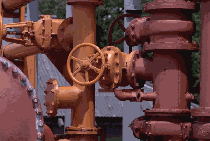 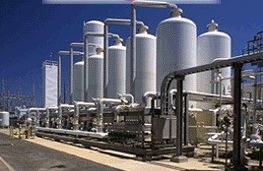
|
|

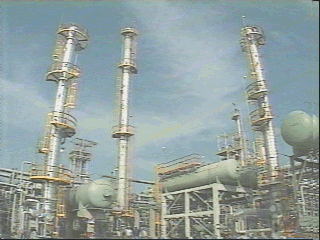 An oil refinery is a more than just a complicated maze of steel towers and pipes. It is actually a factory that takes crude oil and turns it into gasoline and hundreds of other products necessary for our modern society to function.
An oil refinery is a more than just a complicated maze of steel towers and pipes. It is actually a factory that takes crude oil and turns it into gasoline and hundreds of other products necessary for our modern society to function. Separation
Separation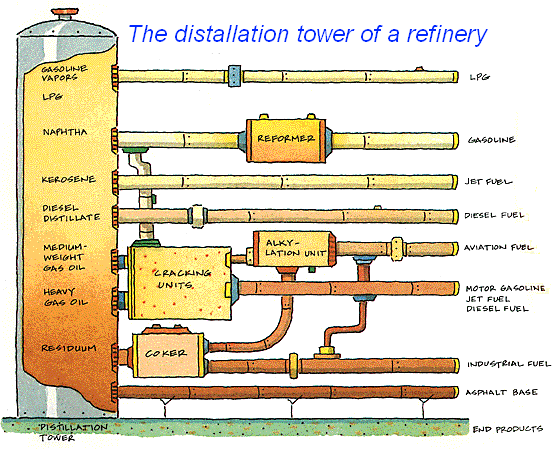
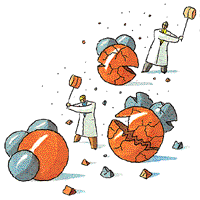 The most widely used conversion method is called cracking, which uses heat and pressure to literally "crack" heavy hydrocarbon molecules into lighter ones. A cracking unit consists of one or more tall, thick-walled, bullet-shaped containers, called reactors, and a network of furnaces, heat exchangers, and other vessels.
The most widely used conversion method is called cracking, which uses heat and pressure to literally "crack" heavy hydrocarbon molecules into lighter ones. A cracking unit consists of one or more tall, thick-walled, bullet-shaped containers, called reactors, and a network of furnaces, heat exchangers, and other vessels.